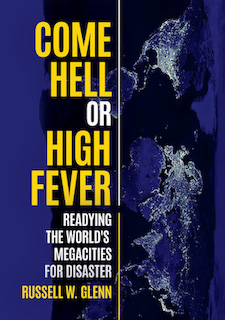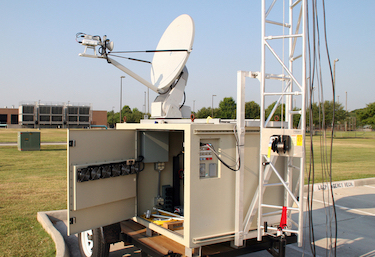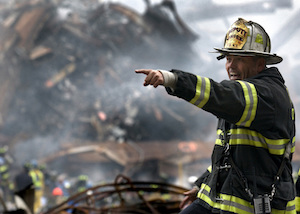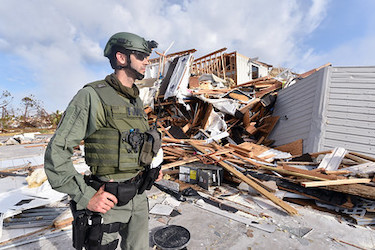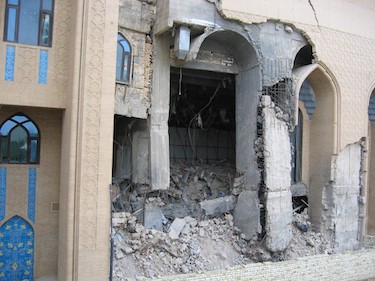Readying for Urban Disaster, Post Four
Russell W. Glenn
The fourth of a series of blog posts on Urban Disasters: Readiness, Response, and Recovery by Russ Glenn.

Urban Density, Iraq. Photo by Dr. Russell W. Glenn
This is the fourth of four posts addressing preparations for urban disaster it has been preceded by seven key points. Next week will see the fifth of what will eventually be a total of fourteen offerings. As noted in our initial post, those remaining will consider responding to urban disasters (four) and recovering from same (six).
Key Point #1: Preparation for any urban disaster helps to prepare an urban area for catastrophes regardless of cause or type.
Key Point #2: Urban disasters are more alike than different.
Key Point #3: Rehearsing/exercising plans—even in so simple a form as talking through challenges—is essential.
Key Point #4: Plans must be executable.
Key Point #5: No plan will survive contact with the disaster.
Key Point #6: Information is the currency of success
Key Point #7: Urban residents are key to successful disaster response. It follows that they are key to successful disaster preparation.
Introduction
We’ll wrap up with a quartet of additional key points. The first:
Key Point #8: The plagues of (1) bureaucracy, (2) poor delineation of responsibilities, and (3) criminality are remoras on any disaster…except the relationship isn’t symbiotic.
Taking us back to our first key point (“Preparation for any urban disaster helps to prepare an urban area for catastrophes regardless of cause or type”), Tash Coxen, a British liaison officer during the Coalition Provision Authority’s early days in Iraq, observed, “One of the problems…is that there had been so little advance planning that much of the organization’s time and focus was taken up simply trying to make itself work.”[1] New York City was similarly hamstrung by organizational shortfalls during our previously presented 1896 heat wave. It was in part a matter of bureaucratic design that crippled both preparing for and responding to disaster in that case. Tenements, sites of so much suffering and death during the heat crisis, fell under the oversight of a Board of Health created in 1867. But building laws were the responsibility of the Department of Buildings. The inevitable tension soon made itself evident. Did airshaft construction and standards constitute a health issue or merely a structural issue?[2] We will recall the lethargy and lack of initiative (concern?) demonstrated by city officials during those disastrous days in NYC. The mayor waited far too long to bring his critical deputies together. The lack of coordination meant that wise decisions such as that by Commissioner Collis to alter work hours (to avoid the worst of days’ heat) were isolated events. The initiative of another, Theodore Roosevelt, to provide free ice to the poor was likewise too rare. The problem rose again a century later…and surely continues today. A committee summarizing issues plaguing Chicago’s response to its 1995 heat wave wrote, “there were significant individual efforts to protect the health and safety of Cook County residents. However, the system as a whole failed.”[3] Such bureaucratic intransigence is embedded in policies, regulations, and other official dictates in addition to its flourishing in government structures. Property rights are vital to urban growth given their assurance that investments will remain protected. Too stringently drawn, however, and they can suppress if not strangle evolutions essential to maintaining metro health.[4]
Bureaucratic shortfalls include limitations on the quality of those holding important positions. A case that will seem familiar to many readers today dates from that same 1995 Chicago heat wave. Chief Medical Examiner Edmund Donoghue had worked in the Medical Examiners Officer since 1977; he had studied other cities’ heat disasters and was thus well prepared to determine which deaths should be attributed to heat-related issues. Despite his expertise and careful use of case records, no less a political profile than Chicago’s Mayor Richard M. Daley "flatly denied the validity of Donoghue’s death reports” given the potential tarnishing his—and Chicago’s—reputations might suffer as a result.[5]
Amidst these recollections regarding quagmires of overlapping responsibilities, political self-service, incompetence, and protectionism, however, glows that reflection of personal initiative. You might not be able to fight city hall, but bright ideas backed by the drive to see them through can sometimes escape bureaucracy’s quicksand.
And I would be remiss were I to imply the bureaucrats in government are always wearing black hats. Sometimes the color of those hats depends on who’s affected and how. Plans and preparations for dealing with future disasters seem inevitably to spawn disagreements among those influenced even by essential change. (See the comment later in this essay regarding NIMBYism.) Initiatives to address flood dangers to New York City’s Manhattan borough are well behind schedule due to protesters fighting destruction of trees or impingements on parks. Officials know they can’t please everyone; some projects forge ahead despite resistance, as they must to mitigate the effects of disasters to come.[6]
Key Point #9: Look backward to look forward.
Will Tokyo’s next disaster be a catastrophic earthquake (odds on favorite)? Massive tsunami (recent analysis reflects that previous estimates of worst case were too conservative)? Eruption of Mount Fuji (now dormant for its longest period in recorded history)? Devastating flooding, perhaps accompanied by widespread mudslides? Key Point #2 advises that “urban disasters are more alike than different.” It follows that looking over our shoulder at those past offers much when readying for others to come. Recalling Tokyo’s earthquake tragedy of 1923, officials viewing the massive loss of life recognized,
the greener and less densely populated former residential districts of the samurai in the hilly western part – the so-called "high city" or Yamanote area – escaped the disaster mostly unscathed. From this, urban planners learned that large urban green spaces like Ueno Park served as an important firebreak and as temporary shelters for those who had lost their homes.[7]
It is a lesson now a century old, but one underlying many of the Japanese capital’s commonsense preparations for inevitable disasters on future horizons. Open spaces and other shelter facilities abound, many fitted with benches that can be converted to grills for cooking and facilities that can be transformed into toilets once surrounded by fences, part of preparations that arguably make Tokyo the best disaster-prepared major urban area in the world.
Another lesson from 1923 Tokyo…and Europe after WWII’s urban devastation, again in post-1945 Tokyo, previously from 1666 London, in microcosm at NYC’s Ground Zero, and in many more instances: recovering from urban disasters presents some of authorities’ toughest challenges and greatest failures. As sure as there will be future disasters in cities, they will be followed by dramatic plans to remake major portions of devastated areas. City officials will surge forward to seize an opportunity to rid their city of previous eyesores, improve transportation flow, expand public spaces, or otherwise introduce what they see as improvements. Architects and urban planners will be anxious to climb aboard the bandwagon. Yet such visions rarely see more than moderate realization, and for good reason. Pre-planning for post-disaster recovery can at best be “big hand over the map” in character: general in nature. After all, the nature of future post-disaster land- and socialscapes consists of many unknowns. That does not negate the value of planning, but it does make clear that flexibility will be essential to pre-disaster response and recovery planning (and to post-disaster disaster planning as well, though in those cases the extent of damage, challenges, and opportunities will obviously be more evident).
Let’s first return to 1666 London to get a sense of the challenges standing in the way of successful post-disaster renewal (and therefore a sense of how hard planning for recovery before an event can be). No less a talent than Christopher Wren (he of Pembroke College Chapel, Cambridge and St. Paul’s Cathedral in London) was among the many offering plans for the capital’s recovery. Few disagreed that some regulation of rebuilding was called for. If nothing else, building standards needed to be put in place to reduce the loss in lives and property next time around. These might be new standards or a tweaking of others existing. (London had provided some guidance in 1580, nearly a century before the Great Fire.) But who would pay for rebuilding? How much would they finance and for what? How long would it take to design and put detailed plans into effect? Who would have priority for allocation of building materials and the related skilled labor needed? (Ever try to get a roofer to repair your home after a storm’s damage?) How would new boundaries be drawn if post-disaster plans were to change street plans or otherwise impose on existing lots? And what to do with all those homeless, school-less, and perhaps medical facility-less residents? London’s authorities agreed that allowing haphazard recovery was not the right answer.[8] But necessity aces intentions. As Christopher Wren designed, authorities planned, and politicians struggled to fund, debates contemplated what should be replaced, what restored, which communities preserved, and which eliminated in the service of “progress.” In the meantime, residents returned to their properties and rebuilt along the same street and property lines as existed pre-conflagration, making mute many of authorities’ ambitions.
The 1923 post-Tokyo earthquake example reinforces many of the above points. In his book The Great Kantō Earthquake and the Chimera of National Reconstruction in Japan, historian Charles Schencking examines proposals by Tokyo’s mayor in the years just prior to the disaster, Gotō Shinpei, who became Japan’s home minister on September 2, 1923, the day following the earthquake. As mayor, Gotō had proposed a grandiose and expensive scheme soon known as the “800 Million Yen Plan”[9] to address many of what he considered the capital’s ills. In the quake’s aftermath, he and those in favor of far-reaching reforms saw the earthquake as a “golden opportunity” to rebuild a truly modern Tokyo despite pre-disaster rejection of the 800 Million Yen Plan. Proposals included widening streets, preventing reconstruction of slums destroyed by the post-earthquake fires, their replacement with public housing estates, an increased number of parks, and expanded community center and clinic availability.[10] The planning reflected urban approaches that would become increasingly sought after as the century progressed: systems approaches melding social and physical infrastructures and recognition that urban areas were integral components of their larger natural environments.[11] But as in 1666 London, these and others underestimated the complex political realities. Those planning also made the oft repeated mistake of not consulting the men and women most affected by these ambitious visions: city residents.[12] Complementing these issues was another too common source of friction as reported in one of the capital’s newspapers not long after the tremors:
The proud city of Tokyo now lies in ruins…. One would have expected them to discuss all the measures…with much greater earnestness and sincerity, but what was the actual state of things? Party sentiment ran even higher than in ordinary sessions, all parties shaping their course with the promotion of party interests primarily in view.[13]
Not all of Tokyo was destroyed. Significant parts of a city will endure even the most disastrous of urban catastrophes (barring, perhaps, the strike of an asteroid, large meteor, or nuclear weapon). Historian Charles A. Beard, close observer and visitor to 1923 Tokyo after the earthquake, wrote:
The burnt area was only superficially cleared; it was not a clean slate, wax in the hands of the artist. It was still a complex of real and potential interests. The street car tracks extending in every direction and representing an investment of millions were intact; while the ruins were yet smoldering, the cars began to run. The water and gas pipes and other subsurface structures remained implanted in the old network of streets, representing millions more of invested capital…. More than a million homeless people and disestablished business men, facing poverty and the approaching winter naturally thought of the coming morrow–of houses and business restored, in any way, as quickly as possible. There were thousands of small landowners in Tokyo, each tenacious of his little right and bent upon holding fast to every inch of his sacred soil.[14]
Within six years, much of destroyed Tokyo had a new street system (now with sidewalks). State of the art bridges, fire-proof public facilities, public housing, and a modest expansion of parks were in place.[15] It was a city modernized in many ways though one far from the Tokyo of today. What its recovery left behind was too many of its pre-earthquake shortcomings. Historian J. Charles Schencking concluded,
Tokyo of 1930 was not a brand new city that emerged from the ruins of its former self. Rather, it was a reconstructed city that possessed many of the same vulnerabilities that existed on the eve of calamity in August 1923. American military planners hoping to coerce submission through urban area bombing during the Second World War were aware of Tokyo’s vulnerabilities and specifically targeted areas that they knew had burned during the 1923 catastrophe: the results were equally devastating in March 1945.[16]
It might be argued that the Japanese learned less from the devastation of 1923 than did external observers across the Pacific. Some Tokyo officials concluded that another opportunity foregone was the chance to address the city’s pre-quake social ills along with its physical ones. While streets, bridges, and other infrastructure saw dramatic improvements, far less was spent on social welfare facilities and related services.[17] And therein lies another point worthy of note:
Key Point #10: Maintaining or improving post-disaster social infrastructure will often be harder than doing so for an urban area’s physical infrastructure.
The vital question implied above is, “What can an urban area do before a disaster to better ready it for recovery thereafter?” Partisan politics, social resistance (e.g., “Not in my back yard” or NIMBYism, to include Hong Kong residents’ not wanting defensive positions installed on their properties in preparation for a possible Japanese invasion, one that came in late 1941), and the failure of Gotō’s ¥800 million plan to gain traction suggests the answer can be “not much.”[18] Even in-place plans that have gained approval may struggle once the reality of implementation is at hand as the below excerpt from my forthcoming Come Hell or High Feversuggests. The topic: New York City authorities’ handling of tough decisions early in the 2020 COVID crisis:
Presciently, the city had put a task force together in 2007 to recommend policies…should a pandemic such as the Spanish flu recur. A report released in 2015 provided recommendations, for example, that patients with some conditions not be put on a ventilator when availability fell short of demand. These included unresponsive patients or those with severe burns, traumatic brain injury, or suffering cardiac arrest. Members of the group involved in the initial task force participated in a mid-March 2020 renewed discussion of the problem. Reconsidered issues included tough choices such as which hospitals should receive newly arrived funding or equipment. Recommendations included favouring previously under-resourced hospitals. A counterproposal noted that better-funded hospitals tended to receive and treat the most vulnerable patients. Fevers burned and patients died as politicians dithered rather than make the tough decisions. The number of deceased became so great that morgues could not keep pace. Refrigerated trailers parked outside medical facilities served as temporary morgues while the report’s recommendations disappeared into the mire of bureaucracy. Doctors, lacking policy guidance, spent resources attempting to save those with little chance of survival. Indecision is a decision in times of crisis.[19]
Thus, in part, the seemingly odd discussion of recovery plans in this, a post with a focus on preparing for urban disasters. As we’ve said, hyper-specific recovery plans are not feasible (specific in the sense of addressing challenges that will remain unknown until a calamity calls on a city). But the above quotation rightly suggests that critical plans regarding aspects generic to virtually any disaster can and should be created. The question then becomes one of authorities’ courage and subversion of self-interest in its aftermath.
Previous key points suggest another. All urban disaster plans—those focusing on response, others looking at components of recovery, generic plans that might have elements for both—should look as far into the future as is feasible. Envisioning what the urban area should look like once response and recovery (or major parts thereof) are complete means that short term goals can be complementary to those more distant. This method of looking at the desired end as the start point for planning, then moving backward in time (or in terms of events accomplished, as planning progress might be better measured in terms of intermediate ends attained than points on a timeline), is called “backward planning” in the military. It has repeatedly proven itself a wise process. Thus the related key point:
Key Point #11: Plan for the end, then the now.
We will wrap up with
Key Point #12: What happens in urban areas doesn’t stay in urban areas…Las Vegas included.
Urban areas are systems and subsystems of larger systems. Cripple the rural environs in proximity to a major city and some food, water, labor, and other resources will suffer interruption. It is unlikely to cripple the urban area for long if at all. Major urban areas tend to possess redundancy for providing essential goods and services. Cripple the urban area on which local rural areas, a region, or the world depends, however, and the consequences can be devastating. Identifying overarching or major vulnerabilities before a crisis is therefore essential. Urban complexity doesn’t make this easy. Determining the source of a power or other service outage can be hard, especially when an attack is deliberate, designed to shield detection, and planned to have broad effects residual to initial targets. Savvy adversaries might achieve their ultimately sought ends by capitalizing on second- or higher-order effects, meaning the initial attack is distant from the desired end effect in terms of time, space, or perhaps both. Smart City initiatives complicate the situation further. These capabilities can speed road repairs, reduce flooding, and otherwise greatly benefit communities. Ironically, while urban authorities tend to be cautious regarding resident concerns regarding protection of private information, they are sometimes less mindful of criminal, foreign power, or other cyber-capable threats that exploit their city’s smart components to ill effect. Hackers have already been successful in manipulating access control systems to facilitate denial-of-service attacks and open smart software doors.[20] These same vulnerabilities and consequences within an urban area can resonate throughout other system parts that rely on the city for their welfare.
Endnotes
This post first appeared as Russ Glenn, “Readying for Urban Disaster, Post 3,” LinkedIn, 31 October 2022, https://www.linkedin.com/pulse/readying-urban-disaster-post-4-russ-glenn/.
[1] 126.
[2] Edward P. Kohn, Hot Time in the Old Town: The Great Heat Wave of 1876 and the Making of Theodore Roosevelt, NY: Basic Books, 2010, p. 80.
[3] Eric Klinenberg, Heat Wave: A Social Autopsy of Disaster in Chicago, Chicago: University of Chicago Press, 2002, p. 138.
[4] Lawrence J. Vale and Thomas J. Campanella, “Conclusion: Axioms of Resilience,” in Lawrence J. Vale and Thomas J. Campanella, ed., The Resilient City: How Modern Cities Recover from Disaster, Oxford: Oxford University Press, 2005, p. 346 (uncorrected advance reading copy).
[5] Klinenberg, Heat Wave, pp. 26-27.
[6] Anne Barnard, “Five Ways to Prevent the Next Sandy,” New York Times, October 28, 2022, https://www.nytimes.com/2022/10/28/nyregion/hurricane-sandy-nyc-10-year-anniversary.html.
[7]
[8] Stephen Porter, The Great Fire of London, Port Stroud, UK: The History Press, 2009, p. 74.
[9] Kantō“800 Million Yen Plan” as Gotō’s response to the disaster. Gotō
[10] Kantō 168-73.
[11] Kantō
[12] Kantō
[13] Kantō
[14] Charles A. Beard, “Goto and the Rebuilding of Tokyo,” Our World, April 1924: p. 14, https://books.google.com/books?id=5oYXAQAAMAAJ&pg=PA11&source=gbs_toc_r&cad=3#v=onepage&q&f=false (accessed September 25, 2022).
[15]
[16] Kantō pp. 305-06.
[17] Kantō pp. 289 and 307.
[18] “Not in my backyard” or NIMBYism: resistance to unpopular projects in proximity to one’s community.
[19] Quotation from Russell W. Glenn, Come Hell or High Fever: Readying the World’s Megacities for Disaster, to be published by the Australian National University Press in January 2023. Material in the passage includes that from Tyler Foggatt, “Protocols: Who Gets a Ventilator?” The New Yorker, April 20, 2020: p. 14; online April 11, 2020 at https://www.newyorker.com/magazine/2020/04/20/who-gets-a-ventilator.
[20] Alexander Braszko, “Military Implications of Smart Cities,” Mad Scientist, June 4, 2020, https://madsciblog.tradoc.army.mil/242-military-implications-of-smart-cities/ (accessed August 15, 2020).
The previous installation of this series “Readying for Urban Disaster, Post Three,” appeared on 18 January 2023.


